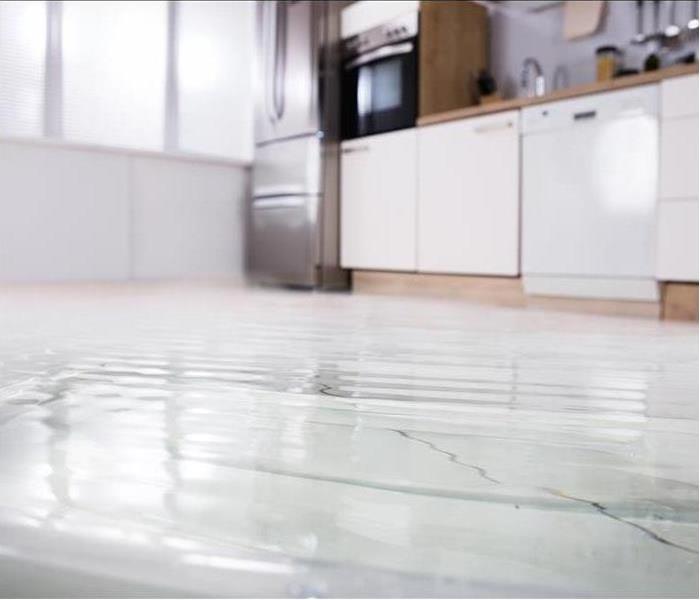What Should I Do if the Water Heater Ruptures and Floods My Bristol House?
8/18/2022 (Permalink)
 If a water damage situation occurs in your kitchen, be sure to contact SERVPRO to remediate the damage. We are available 24/7.
If a water damage situation occurs in your kitchen, be sure to contact SERVPRO to remediate the damage. We are available 24/7.
SERVPRO Responds Fast When Broken Appliances Require Water Removal in Bristol
Although storm damage and overland flooding in Bristol grab the headlines, statistics show that most water losses in residential properties are linked to burst pipes or malfunctioning appliances. Just because a leaking water heater or a faulty pump in a washing machine is a commonplace problem does not mean the damage possible is not severe. Hiring a water damage mitigation and remediation company familiar with extracting significant quantities of fluids is the first step.
How Much Water Can Escape from a Broken Appliance?
The need for water removal in your Bristol home after an appliance malfunction is urgent. For example, if you think about the capacity of a traditional tank water heater providing hot water for showers, dishes, laundry, and handwashing for a family, 50 to 75 gallons is typical. A top-loading washing machine uses 40 gallons, while a front-loading machine uses 20. Dishwashers come in lower at 4 to 6 gallons. If the tank, drum, or outside housing ruptures on any of these appliances, that amount of water flows out, creating a substantial mess even if you notice the event immediately.
What Happens if the Appliance Breaks Overnight or When You Are Away?
Most appliances are plumbed directly into a supply line. If the water is not shut off, it continues to flow into the appliance. Water heaters draw from the line in response to the outflow, and the supply water then adds to the gallons already spilled. If a pump continues operating in the clothes or dishwasher, the same additive effect occurs. Suppose no one is at home or near the appliance. In that case, hundreds of gallons of water fill the space of origin and then spread throughout the rest of your home, causing additional water damage issues in Bristol.
Emergency Services
Once safety concerns are addressed, our crews rapidly remove the standing water. If electricity is shut off in your residence, our gas-fueled and submersible pumps avoid delay in our response. After the water level dips below two inches, our truck-mounted heavy-duty extractors also can operate off generators. Team members systematically move through the wet spaces, using wanded attachments to suction liquids. Squeegees push the decreasing quantity of water towards the extractors.
Moisture Detection and Metering
Our technicians use their Institute of Inspection, Cleaning and Restoration Certification (IICRC) training to sketch out the extent of the water migration using sensitive devices first to locate and then measure the remaining moisture. Thermal imaging also helps detect the presence of trapped water. Moisture data is charted to provide a baseline for the final stage of water removal and structural drying.
Eliminating Trapped Water
The final stages of a water removal job involve evacuating moisture not easily extractable. Two main challenges present:
Releasing Trapped Standing Water
Water can collect in a wide range of building cavities, untouchable by pumps and truck-mounted extractors. When we locate these caches, several strategies permit success:
- Portable extractors with wand extenders can improve efforts in confined spaces.
- Controlled demolition such as partial removal of drywall or paneling (flood cuts) or drilled or cut holes release hidden water for removal.
Evaporating Absorbed Moisture from Structures
Our Applied Structural Drying (ASD) technicians determine drying goals based on the moisture data gathered earlier, including moisture levels in similar materials in an unaffected area of your home. We strike a scientifically-based balance of air movement, temperature, and humidity that facilities the movement of moisture from building materials into the air as a vapor. The vapor is then collected and discarded. Equipment operated to achieve the balance and effectuate the removal includes:
- Air movers
- Heaters
- Dehumidifiers
Our crew monitors the process, counting on the homeowner to leave the equipment on and in place to reach the drying goals.
How can SERVPRO of Bristol help after your home floods because of an appliance malfunction? Call us at (860) 582-3330 and learn how our trained, experienced, and well-equipped employees can make it “Like it never even happened.”

 24/7 Emergency Service
24/7 Emergency Service